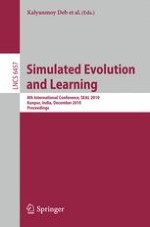2010 | Book
Simulated Evolution and Learning
8th International Conference, SEAL 2010, Kanpur, India, December 1-4, 2010. Proceedings
Editors: Kalyanmoy Deb, Arnab Bhattacharya, Nirupam Chakraborti, Partha Chakroborty, Swagatam Das, Joydeep Dutta, Santosh K. Gupta, Ashu Jain, Varun Aggarwal, Jürgen Branke, Sushil J. Louis, Kay Chen Tan
Publisher: Springer Berlin Heidelberg
Book Series : Lecture Notes in Computer Science
